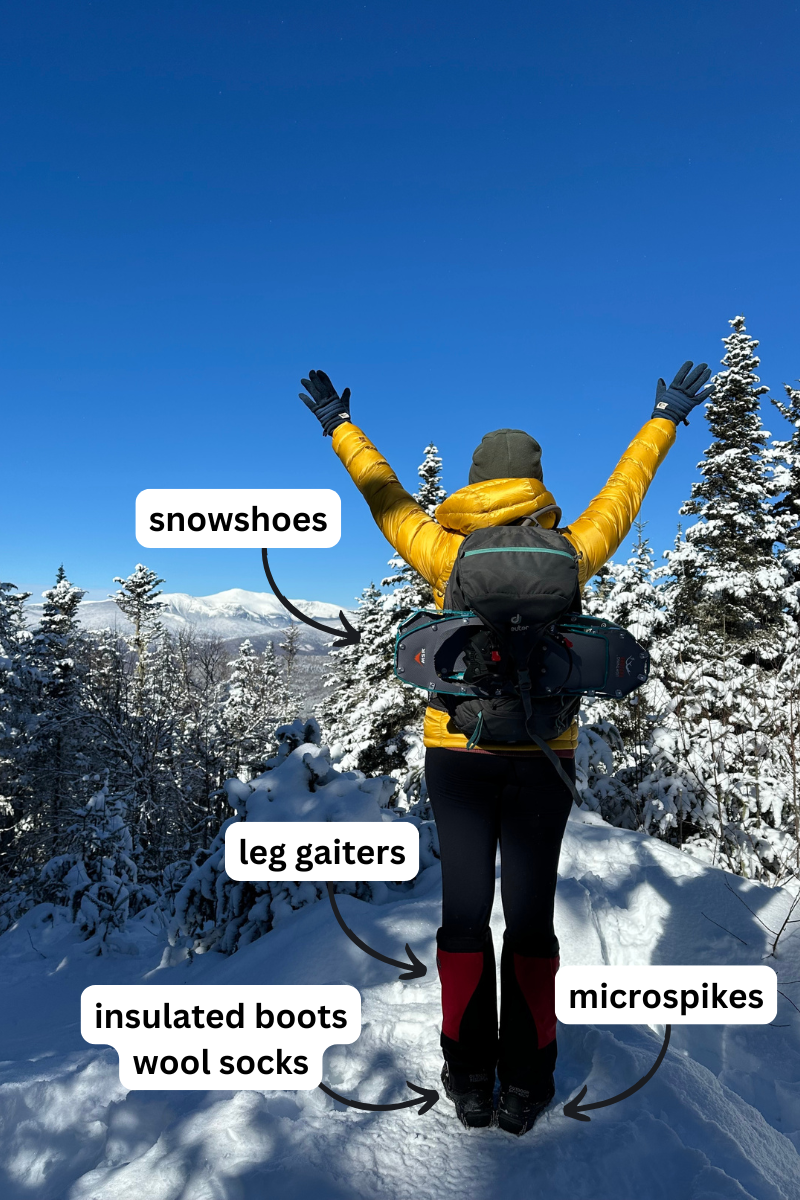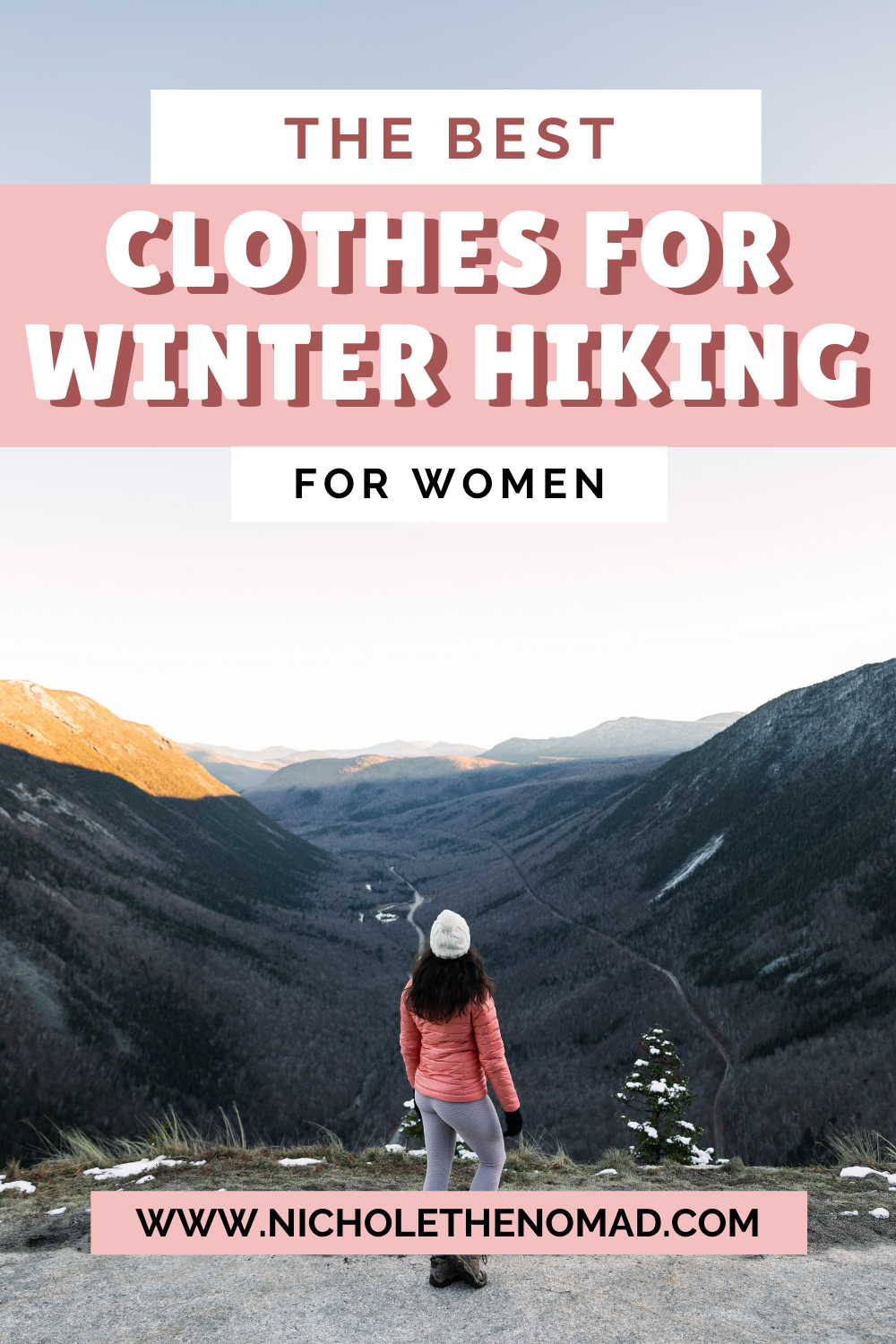What to Wear Winter Hiking: Best Winter Hiking Clothes
If you want to hike in the winter, it is crucial to understand the importance of winter hiking clothes and how to layer them. Winter and cold weather brings higher risks while hiking, including frostbite and hypothermia, but good winter hiking clothes will help keep you warm, dry, and protected against harsh and cold conditions.
Even though I have been winter hiking for years, I still learn something new each time I go out. Every hike is different, depending on the length, difficulty, conditions, and weather, making it crucial to pack for anything you might encounter.
Even if you will be hiking on a sunny winter day or an easy trail, it is important to be prepared and pack layers. This guide has everything you need to know about what to wear for winter hiking, including the best winter gear, how to layer, and winter hiking tips.
Disclaimer: This post contains affiliate links. If you click through and make a purchase, my blog may receive a commission at no additional cost to you.
Tips for Winter Hiking
What you wear and pack depends on where you are hiking, the weather, and the conditions. These are just general guidelines to follow for winter hiking! I also recommend trying out different layering systems on shorter and easier hikes to see what is going to work best for you and to familiarize yourself with your gear.
Important Things to Know
Do not wear cotton. Cotton takes a very long time to dry, so if it gets wet from the elements or sweat, it will not help you keep warm or dry. It is crucial to have base layers that are merino wool or synthetic fabric because they help regulate body temperature and wick moisture as you sweat.
Start cold, be bold. I am sure you have heard this phrase, but it is important! You want to try to regulate your body temperature and avoid sweating through your layers because that can cause a bunch of issues.
Layers are crucial. It is critical to make sure you wear and pack the appropriate winter hiking layers that keep you warm and dry when winter hiking. The typical layering system consists a base layer that wicks moisture, a mid-layer that insulates you, and an outer shell that is windproof and waterproof. We will talk more in-depth about layers in the next section! I also recommend packing extra layers!
Wear sunscreen. The sun can reflect from the snow and cause a sunburn, making it crucial to wear when hiking in the winter.
Use water bottles instead of a hydration reservoir. Hydration reservoirs can easily freeze, especially the tube and valve. Because water freezes from the top down, you can pack a water bottle upside, which will allow you to still drink the water. You can also buy insulated sleeves for water bottles. If you would rather have a hydration reservoir, you can buy items that help insulate the tube and valve.
Pack batteries close to your body. Batteries die quickly in cold weather, so I recommend packing anything that has a battery close to your body or in a thick, warm sock. This can include cell phones, external batteries, headlamps, and GPS devices.
Check the weather before you head out for your hike. The weather in the mountains is unpredictable year-round, making it crucial to check the weather before you leave for your hike. Checking the weather allows you to reevaluate the gear you packed or if you might want to move your hike to a different day.
Don’t be afraid to turn around. It is crucial to listen to our bodies and pay attention to the weather and conditions around us while we hike. Do not be afraid to turn around for any reason. It is better to be safe!
Always pack the Ten Essentials. You should always always always pack the Ten Essentials on every hike, no matter the difficulty or length.
How to Layer for Winter Hiking
Understanding the importance of layering winter hiking clothes and how to layer them is crucial. The basic layers consist of a base layer, mid-layer, and outer shell, and they will help keep you warm and dry.
Note: I do not wear these layers all at once on every winter hike. What I wear depends on the weather, wind, and if I am above the treeline. Usually I start with wool base layers, and as I make my way above the treeline, I put on more layers to keep me warm and protected from the wind.
Base layers will be what is next to your skin and help regulate your body temperature and wick your sweat. The best base layers are made of merino wool and synthetic fabric because they dry quickly and wick moisture well.
Insulating layers are crucial winter hiking clothes layer to help retain your body heat while you are winter hiking. This layer is typically made of down, synthetic down, or fleece.
Fleece jackets are warm and breathable, but you will still need a shell layer over them. I typically wear a light fleece jacket under my puffy jacket.
Down jackets are warm, lightweight, and compressible. The only drawback to down is it loses its efficiency when it gets wet. Synthetic down jackets are similar to down jackets but don’t compress down well and perform better when wet.
Outer shells help keep you dry and protect you from the elements when winter hiking, so it needs to be windproof and waterproof. Some hikers prefer a light waterproof outer shell while others prefer an outer shell with some insulation.
What to Wear Winter Hiking
As I mentioned above, what you wear and pack for your hike depends on many variables, but I usually pack every one of these pieces of gear for my winter hikes. These are just general guidelines on what to pack for your winter hike.
Winter Hiking Footwear
Wool Socks: Making sure your feet are warm, dry, and supported is crucial when winter hiking! And that starts with wearing warm socks made of synthetic fabric or wool. These socks will help keep your feet warm while wicking moisture. I also pack extra socks to change into if necessary and to hold batteries and any pieces of gear with batteries.
Insulated Hiking Boots: When you are hiking in cold and snowy conditions, it is important to wear waterproof and insulated winter hiking boots to keep your feet warm and dry. Winter hiking boots typically have 200g or 400g insulation. You will most likely be okay with 200g, but if you are hiking in below-freezing temperatures, you should consider buying 400g insulation winter hiking boots.
Leg Gaiters: Gaiters are crucial winter hiking clothes if you want to make sure the snow stays out of your boots and pants. The gaiters you wear should be waterproof and attach to your winter hiking boots.
Microspikes: Winter hiking brings icy trails, so having traction will help keep you safe and prevent you from slipping. Micropsikes are very helpful to wear when you are hiking on a flat and icy trail. They fit around your winter hiking boots, so you can easily put them on when needed.
Crampons: Crampons are similar to microspikes but have larger spikes. The larger spikes help grip ice more than microspikes on steep inclines. Similar to microspikes, crampons also fit around your winter hiking boots.
Snowshoes: Snowshoes are worn when winter hiking in deep snow because they help you stay on top of the snow rather than post-holing. Similar to microspikes and crampons, snowshoes attach to your winter hiking boot and are easily removable.
Winter Hiking Pants
- Base Layer Pants: One of the most important layers of winter hiking clothes is your base layer pants. Base layer pants will wick moisture and help regulate your body heat when winter hiking and should be made of merino woolsynthetic fiber.
- Fleece Pants: If you are someone who runs cold like me, you may want to consider fleece pants! Fleece leggings are my favorite winter hiking pants, and I usually wear these instead of my wool leggings because I run cold. Fleece is a great insulator and helps keep your legs warm while hiking.
- Waterproof Pants: You will also want to have a pair of waterproof hiking pants to wear over your base layer pants to protect you from wet conditions. Any waterproof pants will work well for this winter hiking layer, including ski pants. If you will not be hiking in wet conditions, you can wear a thick and warm pair of leggings for this layer.
Winter Hiking Tops
- Base Layer Top: Similar to base layer pants, one of the most important layers of winter hiking clothes is your base layer top. Your first base layer top should be made of merino wool or synthetic fabric, so it can wick moisture and help regulate body temperature when winter hiking. There are different thicknesses for base layer tops, and choosing the right one will depend on your personal preference and how cold it will be where you are hiking.
- Fleece Jacket: Because I run cold, I like packing a fleece jacket as another insulated layer under. I tend to layer it under an insulated puffy jacket if it is cold or windy.
- Puffy Jacket: An insulating layer is one of the most important layers because it helps you retain your body heat. This layer is typically made of down or synthetic down. I prefer a down jacket, but both are great jackets!
- Outer Shell Jacket: An outer shell jacket is windproof and waterproof, making it a crucial piece of winter hiking gear to protects you from the elements. These jackets can be rain jackets or have a layer of insulation, and the type of outer shell jacket you choose is up to your preference.
Winter Hiking Accessories
Gloves: You should always pack two pairs of winter hiking gloves. I always pack a pair of lightweight fleece gloves to wear pretty much at all times and waterproof mittens to wear once I get above the treeline or if it is snowing.
Hat: Because we lose a lot of body heat through our heads, it is crucial to wear a warm hat when winter hiking. A hat will help you retain body heat and keep you warmer while in cold temperatures.
Neck Gaiter: Our nose and cheeks are just as important to protect from conditions while winter hiking as the rest of our body. A wool neck gaiter or face mask will help protect your face when exposed to cold wind and temperatures.
Sunglasses and Goggles. Because the sunlight can reflect off the snow into your eyes, it can harm your eyes more than you think, so I recommend packing polarized sunglasses. Goggles are helpful when you are hiking above the treeline, where the conditions and wind can be harsher.
Headlamp: A headlamp is part of the 10 essentials, but I wanted to call it out separately. I highly recommend packing two headlamps with extra batteries for both. Since batteries tend to drain quickly in cold weather, it is important to pack extra and keep them in a wool hiking sock.
Hand and Feet Warmers: Even if we wear the warmest gloves and socks, our hands and feet are still likely to get cold during a winter hike. Hand and feet warmers can be great ways to help warm up! Hand warmers can easily fit into your gloves, and feet warmers attach to your sock to keep your feet warm.
Avalanche Equipment: Winter hiking can pose more risks, so it is crucial to have a safety plan. If you will be hiking in an avalanche-prone area, you should always check the conditions with a land manager and pack technical winter gear, including an ice axe, avalanche shovel, avalanche beacon, and avalanche probe.
This guide is a great place to find recommendations for what to wear for winter hiking, including winter hiking clothes, the importance of layering, and winter hiking tips.
Hey, I’m Nichole!
I am the creator behind Nichole the Nomad, the home of my explorations around the world, mountain hikes, and beautiful pictures taken along the way. I have a deep passion for capturing the world in a beautiful light and sharing my experiences.
I created this blog to share my travels, show how beautiful the world is, provide tips and tricks for traveling, and encourage you to explore. Whether you want to travel across the world or explore what’s in your backyard, I hope this blog inspires you to get outside and find your adventure!
Pint it for later!










